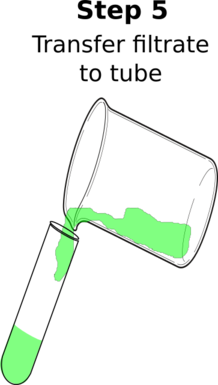Table of Contents
DNA Extraction
Before You Begin
Answer the following questions with your lab group:
- What are fruits?
- Where do they come from?
- What are they made of?
- Use phylogeny to classify plants (DKPCOFGS).
- Where is DNA located within the fruits? Where is it located in you?
- Why would you want to extract DNA from an organism?
- What class of molecule is DNA?
Materials
Each lab group will need the following materials:
- sample of fruit (banana, strawberry, or grapes)
- salt solution
- liquid detergent (soap)
- cold ethanol
- 1 Ziplock bag
- 1 coffee filter
- 1 rubber band
- 1 beaker
- 2 test tubes
- test tube rack
- stirrer or glass rod
Method
- Mash about 10 g or 3 cm of over-ripe banana OR 3 grapes OR 1 strawberry in zip-top bag.
- Over-ripe banana is best since the cell walls are already decomposing.
- Physical mashing continues to break up the cell walls.

- Add 7 ml of salt solution.
- The salt solution helps the DNA to aggregate (clump together).

- Add 7 ml of liquid detergent and mix.
- The detergent dissolves the lipids in the cell and nuclear membranes.
- This releases the DNA into the salt solution.

- Place a coffee filter over a cup or beaker and fasten with an elastic band. Pour the mash into the filter and wait for the liquid to drip through the filter.

- Pour about 5 ml of filtrate into a test tube.

- Slowly pour an EQUAL volume of cold ethanol down the side of tube to form a layer on top of the fruit fluid.
- Carefully run the alcohol down the side to form a separate layer on top of the fruit solution.
- Do not mix the alcohol and the fruit solution.
- Ice-cold 100% ethanol works best.

- Spool the DNA: use a plastic loop or glass rod to gently swirl at the interface of the two solutions.
- The interface is where the two solutions meet.
- DNA is not soluble in alcohol.
- Bubbles may form around a wooly substance (this is the DNA).

- Transfer the DNA to an empty test tube.




